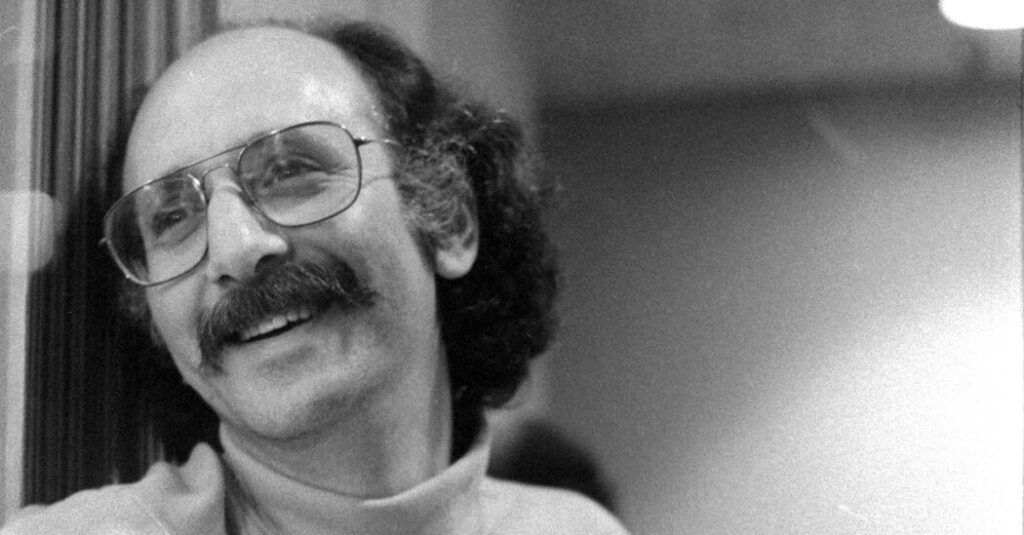Near the end of “A Complete Unknown,” the Bob Dylan biopic that centers on his move into rock in 1965, an earnest, slim, bearded, clearly nervous M.C. struggles to pacify a wildly divided crowd that has just heard Dylan sing three plugged-in songs at the Newport Folk Festival. Boomers will immediately recognize that M.C. as Peter Yarrow, himself a festival headliner in the folk-revival trio Peter, Paul and Mary.
Yarrow, who died on Tuesday at 86, was also a member of the Newport Folk Festival board that had been striving to balance the event’s founding mission — bringing traditional music to a wider audience — with the preferences of that wider audience, which was more drawn to pop than purism. Among the festival organizers, Yarrow was an advocate for the topical songwriting and contemporary sounds that some old-line folk aficionados resisted. (According to “White Bicycles” by the producer Joe Boyd, who was running the sound system at Newport in 1965, Yarrow was also at the control board during Bob Dylan’s loud, divisive electric set, and refused to turn it down as other board members demanded.) And in the early, idealistic years of the folk revival, Yarrow, Noel Paul Stookey and Mary Travers (who died in 2009) strummed and harmonized their way toward that conscientious balance of folk and pop. It was sincere, and fleeting.
Peter, Paul and Mary — Stookey performed under his more biblical middle name — hit America’s cultural sweet spot in the early 1960s. They garnered radio hits and No. 1 albums by prettifying folk songs and smoothing out protest material from Dylan and Pete Seeger. They also made their politics clear by singing at the 1963 March on Washington for civil rights, and they brought out antiwar, anti-establishment subtexts in old songs like “Cruel War” and “If I Had My Way.”
Meanwhile, using lyrics from a college acquaintance, Yarrow wrote a lilting, enduring children’s song — “Puff (The Magic Dragon)” — that gained immeasurable mileage from what he always insisted was a misinterpretation: that it was about puffing marijuana.
Like pop groups before and since, the trio was the calculated project of its manager, Albert Grossman, who envisioned commercial possibilities for a folky harmony group with a woman and two men. He had approached other Greenwich Village figures — among them Dave Van Ronk and Carolyn Hester — before the trio’s lineup jelled in 1961.
Peter, Paul and Mary quickly emerged as the winning 1960s iteration of a clean-cut, meticulously arranged supper-club and concert-hall approach to performing folk songs, passed down from 1950s groups like the Weavers and the Kingston Trio.
The group arrived as polished, presentable representatives of the 1960s Village folk scene. On the cover of their self-titled 1962 debut album, they posed against a brick wall at the Bitter End club, with Yarrow and Stookey sporting Brooks Brothers suits and matching goatees. Elijah Wald’s book “Dylan Goes Electric!” noted that The New Yorker magazine’s early 1960s nightlife listings concisely described them as “two beards and a doll.”
The Peter, Paul and Mary sound was never raw or unplanned. It was intricate and decorous, usually with just three voices, two guitars and the discreetly jazzy underpinning of a bass fiddle. The vocal parts were thoroughly rehearsed, with the three singers exchanging leads or backing each other with carefully plotted dynamics. Their voices achieved a particular blend: three kinds of reediness, with Yarrow’s tenor neatly placed between Stookey’s baritone and Travers’s contralto.
Yarrow’s own behavior was hardly as kindly as the sound of his group. In 1970, he pleaded guilty to taking indecent liberties with a minor, and was sentenced to prison. He served just under three months and was later pardoned by President Jimmy Carter, in 1981. “I do not seek to minimize or excuse what I have done, and I cannot adequately express my apologies and sorrow for the pain and injury I have caused in this regard,” he told The New York Times in 2019.
Peter, Paul and Mary’s music was far removed from the rawness and spontaneity (and often the songwriting credits) of their traditional sources. In hindsight, the trio sounds close to the chamber-pop of the late 1960s, a precursor to the Mamas and the Papas, the Association and Simon and Garfunkel. But in their day, they were a bridge from a sometimes scruffy folk scene to nationwide pop accessibility. They made Top 10 radio hits of Seeger’s “If I Had a Hammer” and Dylan’s “Blowin’ in the Wind” and “Don’t Think Twice, It’s All Right” — crucial for Dylan’s career, though his own versions proved equally enduring.
Folk-rock and psychedelia would make Peter, Paul and Mary sound pallid and precious, although nostalgia sustained them through a later reunion career. But in the early 1960s, they were the right group for the moment: refined, genteel training wheels on the motorcycle roar that lay just ahead.


